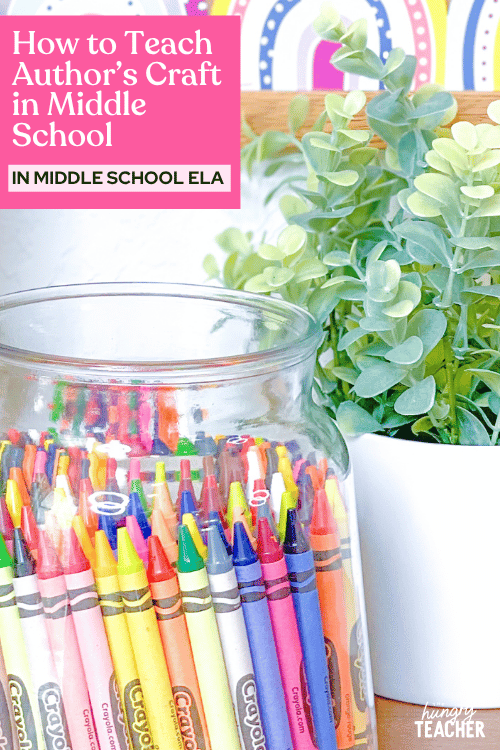hey friend!
I'm Martina.
I provide practical, time-saving strategies that actually work—so you can engage your students, teach effectively, and reclaim your time from the exhausting planning-grading cycle.
Browse Our ELA Resources
How to Teach Author’s Craft in Middle School
Teaching author’s craft used to be something that intimidated me. Author’s craft sometimes feels like a whirlwind of vocabulary and information. How was I going to get my students to remember all of this, much less apply it to their reading?
Like any good teacher, I spent lots of time looking for resources on author’s craft. I found helpful information along the way, but I could never find one comprehensive guide to how to teach this monstrosity of a topic. That’s about to change.
I am going to share all the things I wish I knew when I was struggling to teach author’s craft. In this guide, I will talk about what is author’s craft, how to teach it, and how to help students analyze a text with author’s craft.
WHAT IS AUTHOR’S CRAFT?
Author’s craft is the techniques an author uses to convey a story. The definition sounds pretty simple, but what makes author’s craft a challenge for students (and teachers) is that authors can use a ton of techniques. These techniques include things like figurative language, imagery, text structure, genre, dialogue, and much more.
The biggest injustice we can do to our students is simply throw vocabulary in their notebooks and walk away from it. In order to prepare our students for applying author’s craft to their reading and writing, we have to build a strong foundation for them.

HOW DO I HELP MY STUDENTS BECOME FAMILIAR WITH AUTHOR’S CRAFT TECHNIQUES?
If we want our students to be masters of author’s craft, we need to break this topic down. Start by creating a unit as a glance. Essentially, you want to map out how to fit in all the elements of author’s craft, so that you have time to get your students familiar and comfortable with each craft.
It may help to give your students a list of all the author’s craft techniques at the beginning of the unit, but don’t try to explain each element for the first time in one class period. That will have you and your students feeling overwhelmed. Instead, explain to students that you will be exploring each topic over a period of time.
Then, slowly work your way through each element. I would give your students an overview of a topic and then have them practice applying it to a text. For example, you might review point of view with your students. Then, read a short story with your students and have them identify the point of view. Ask students why the author chose this POV and how the story would be different if in another POV. Continue this process as you work through the different author’s craft techniques.

MY STUDENT UNDERSTAND AND CAN IDENTIFY THE DIFFERENT TECHNIQUES. WHERE DO WE GO FROM HERE?
When students begin to show an understanding of author’s craft, it’s time to move up the bloom’s chart. We want to move from simply remembering and understanding to applying and analyzing. This is where literary analysis comes in.
A literary analysis is an essay that makes an argument about a text. During a literary analysis, the student is typically examining an author’s theme, craft, tone, or other literary element. When writing a literary analysis, students have to move beyond basic understanding of literary devices. Not only must they recognize the device being used, but be able to explain its significance in the text and why the author chose to use it.
Since we have been talking about author’s craft, let’s look at how they would be utilized in a literary analysis essay. A student might read a text and note that the author frequently uses flashbacks. The student would then analyze why the author uses flashbacks in the text and how it contributes to the story. In their literary analysis, they would include items such as a summary of the text, an analysis of the flashbacks, any relevant text evidence, and counterclaims. When you first begin writing literary analysis with your students, you may have to do lots of modeling – and that is totally okay! Students will become more confident with time.

Not sure where to start with literary analysis essays? If you want guidance on how to get your students writing great essays, I have a full literary analysis unit for middle school students. This unit contains five weeks of lessons and provides you with all of the materials you need to teach the unit.
Remember that author’s craft doesn’t have to stop at literary analysis. The ability to recognize and apply author craft extends well into high school and beyond. As the school year moves forward, continue to spiral in author’s craft. Challenge students by having them analyze new genres or even make comparisons across genres.
Want a sneak peek at teaching The Hungry Teacher way—with support, structure, and strategy?
When you join the waitlist for The Hungry Teacher’s Hub membership, you get three free classroom-ready resources: a theme unit, an expository writing unit, and a grammar unit introducing mentor sentences. Plus, you’ll get immediate access to a selection of exclusives from the Hub, including editable sub plans, pacing guides, and more.
No strings attached. Just resources you can use right now—and a heads-up when the Hub opens.
3 Free Middle School ELA Units—yours to keep!
JOIN THE WAITLIST + A FREE GIFT
Where to next, line leader?
Welcome to The Hungry Teacher! We create resources that are easy to use, practical, and get results. Teach with confidence—and make it home before dinner.
xo, the hungry teacher